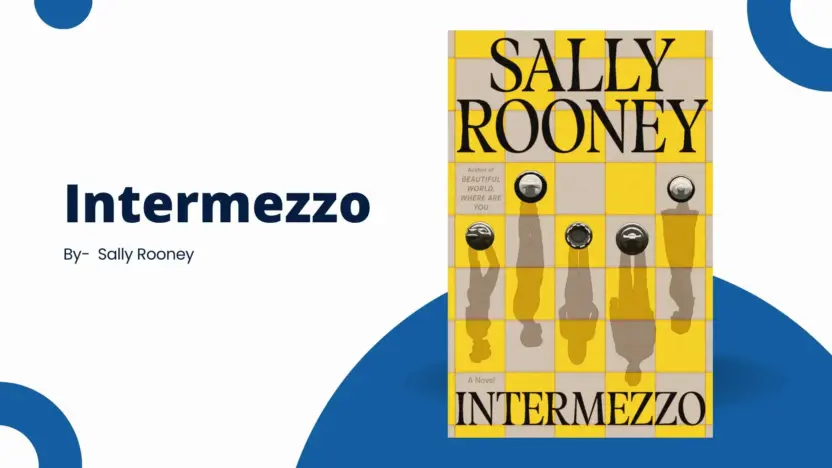Sally Rooney’s Intermezzo marks her much-anticipated fourth novel, building on the themes of interpersonal dynamics, identity, and societal pressures that have characterized her previous works. In this novel, Rooney takes a leap, focusing on familial bonds rather than the romantic entanglements that dominated Normal People and Conversations with Friends. The story revolves around two brothers, Peter and Ivan Koubek, who are forced to confront grief, memory, and their strained relationship after the death of their father. Through Intermezzo, Rooney explores deeper, emotionally charged territory, making it one of her most intimate works to date.
Plot Overview: A Tale of Grief and Self-Discovery
At its heart, Intermezzo is a story about loss and reconciliation. Peter, a successful lawyer in his thirties, grapples with insomnia and emotional paralysis after the loss of his father. He is caught between two contrasting relationships—his lingering attachment to Sylvia, his first love, and his complicated romance with Naomi, a vibrant but aloof college student. Meanwhile, Ivan, his much younger brother, is a chess prodigy who finds himself struggling with feelings of inadequacy and social awkwardness. Their journey through grief forces them to confront old wounds and rediscover their shared history, ultimately revealing how the death of a parent can shake the foundation of even the most complicated sibling bonds.
Rooney intricately weaves the narrative through the internal monologues of both brothers, offering readers an in-depth look at their inner turmoil. The characters’ raw vulnerability, often hidden beneath layers of unspoken resentment, is where Intermezzo thrives as a meditation on grief and identity.

Characterization: A Study in Contrasts
The dynamic between Peter and Ivan is central to the novel’s emotional core. Rooney’s portrayal of their complex relationship is masterful, contrasting Peter’s confident exterior with Ivan’s introverted and insecure nature. Peter is a man defined by his success, yet beneath the surface, he is emotionally fractured and unable to process his grief. Ivan, on the other hand, has always lived in his brother’s shadow, struggling to carve out his own identity. Rooney effectively explores how sibling relationships evolve over time, as past rivalries and unresolved issues rise to the surface.
Naomi, the working-class student involved with Peter, introduces Rooney’s recurring theme of class dynamics, adding an extra layer of tension to the narrative. Her relationship with Peter highlights the subtle power imbalances present in their lives, making Naomi both drawn to and resentful of Peter’s privilege. This exploration of class further enriches the story, though it remains more understated compared to Rooney’s previous works like Beautiful World, Where Are You?.
Themes: Memory, Identity, and Class
Memory plays a pivotal role in Intermezzo, as Peter and Ivan’s recollections of their father diverge, creating a narrative tension that shapes their grieving process. Rooney’s handling of memory is both poignant and nuanced, as she shows how their interpretations of shared experiences differ, influenced by their own biases. This theme comes to a head during a climactic argument between the brothers, where long-buried resentments come to the forefront. The novel deftly captures how the stories we tell ourselves about our family and our pasts often shape our present, for better or worse.
Rooney also uses class dynamics to subtly inform the characters’ relationships. The contrast between Peter’s financial stability and Ivan’s precarious position underscores the economic divide that can shape family dynamics. Similarly, Naomi’s relationship with Peter is tinged with a sense of imbalance, as her working-class background clashes with Peter’s affluence. Rooney explores these tensions with her usual precision, offering a commentary on privilege and its impact on personal relationships.
Narrative Style: Internal Monologues and Fragmented Conversations
One of Rooney’s most distinctive traits is her ability to capture the rhythms of contemporary speech, and Intermezzo is no exception. Her dialogue is often fragmented and indirect, mirroring the way real people converse. The characters’ conversations meander, with thoughts left unfinished, adding a layer of authenticity to their exchanges. Moreover, Rooney’s use of internal monologues allows readers to experience the characters’ deepest thoughts, creating an almost claustrophobic sense of intimacy. This technique may feel risky, but it ultimately pays off, drawing readers closer to the characters’ emotional landscapes.
Conclusion: A Quietly Powerful Novel
Intermezzo cements Sally Rooney’s place as one of the most insightful and empathetic authors of her generation. While it may not have the romantic intensity of her earlier works, its exploration of grief, family, and identity is equally, if not more, emotionally resonant. Rooney’s ability to capture the quiet moments of life—the interludes between significant events—makes Intermezzo a profound reflection on the human experience. The novel lingers in the mind long after the final page, reminding us that even in the darkest times, understanding and connection can be found.
Also Read: Counting Miracles: By Nicholas Sparks (Book Review)



